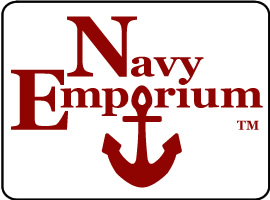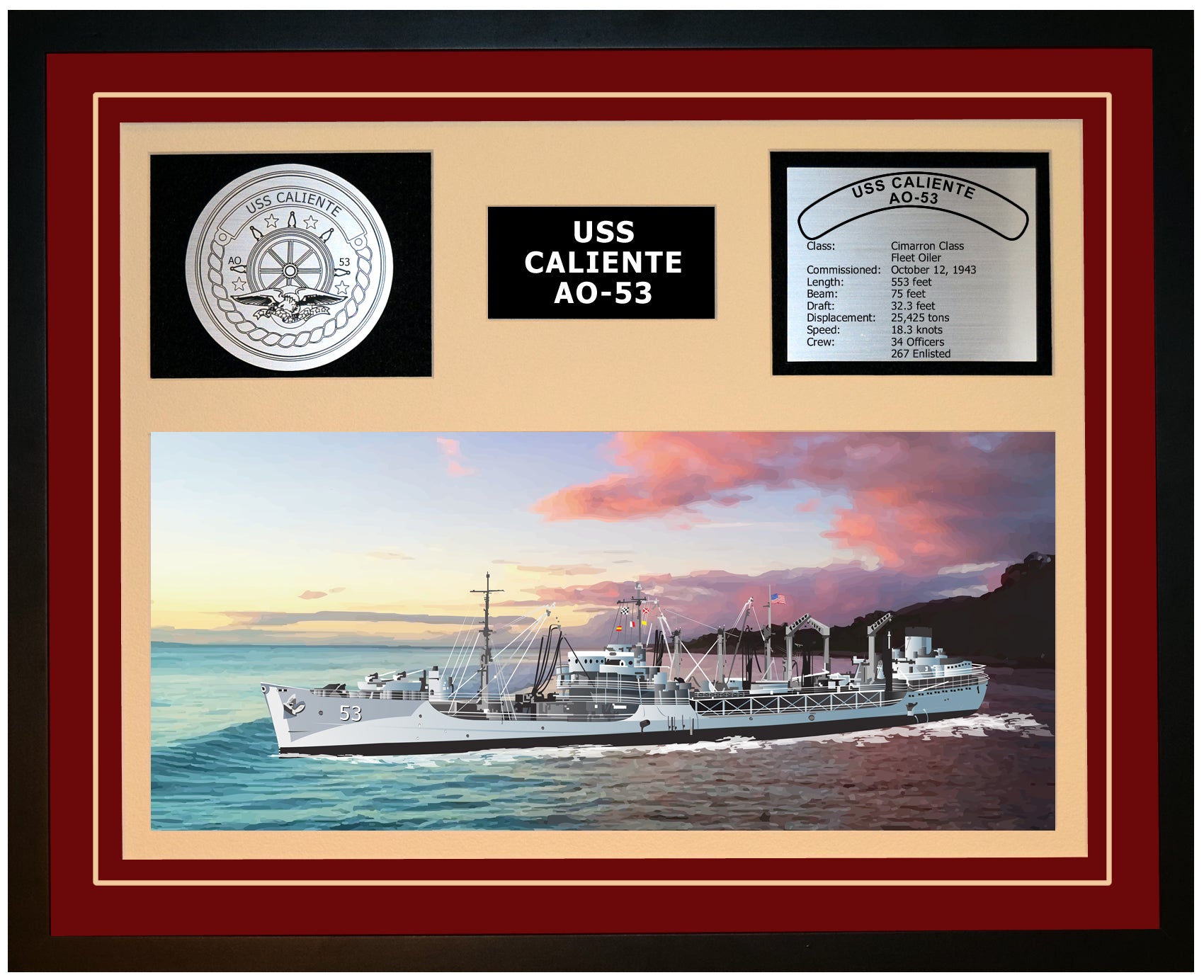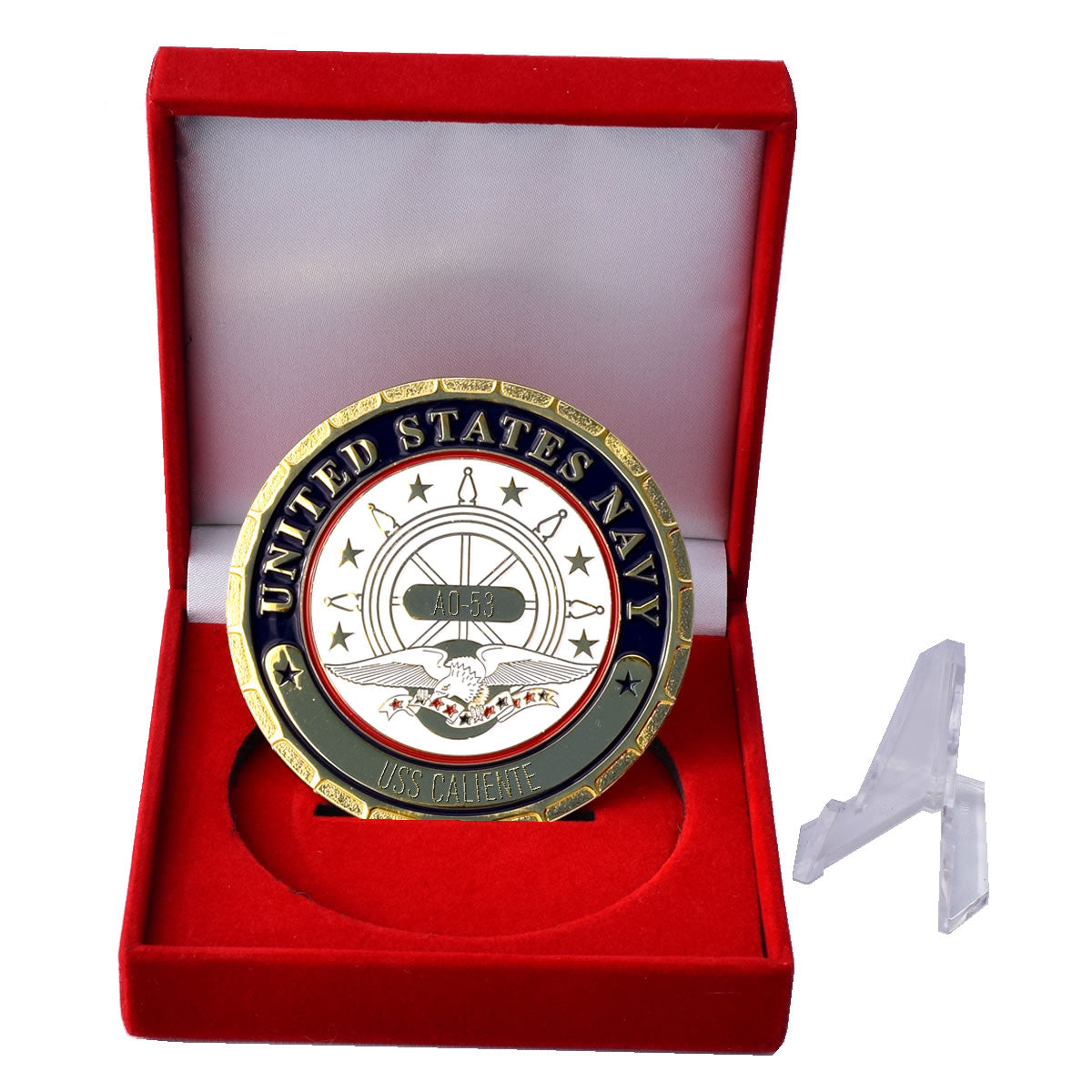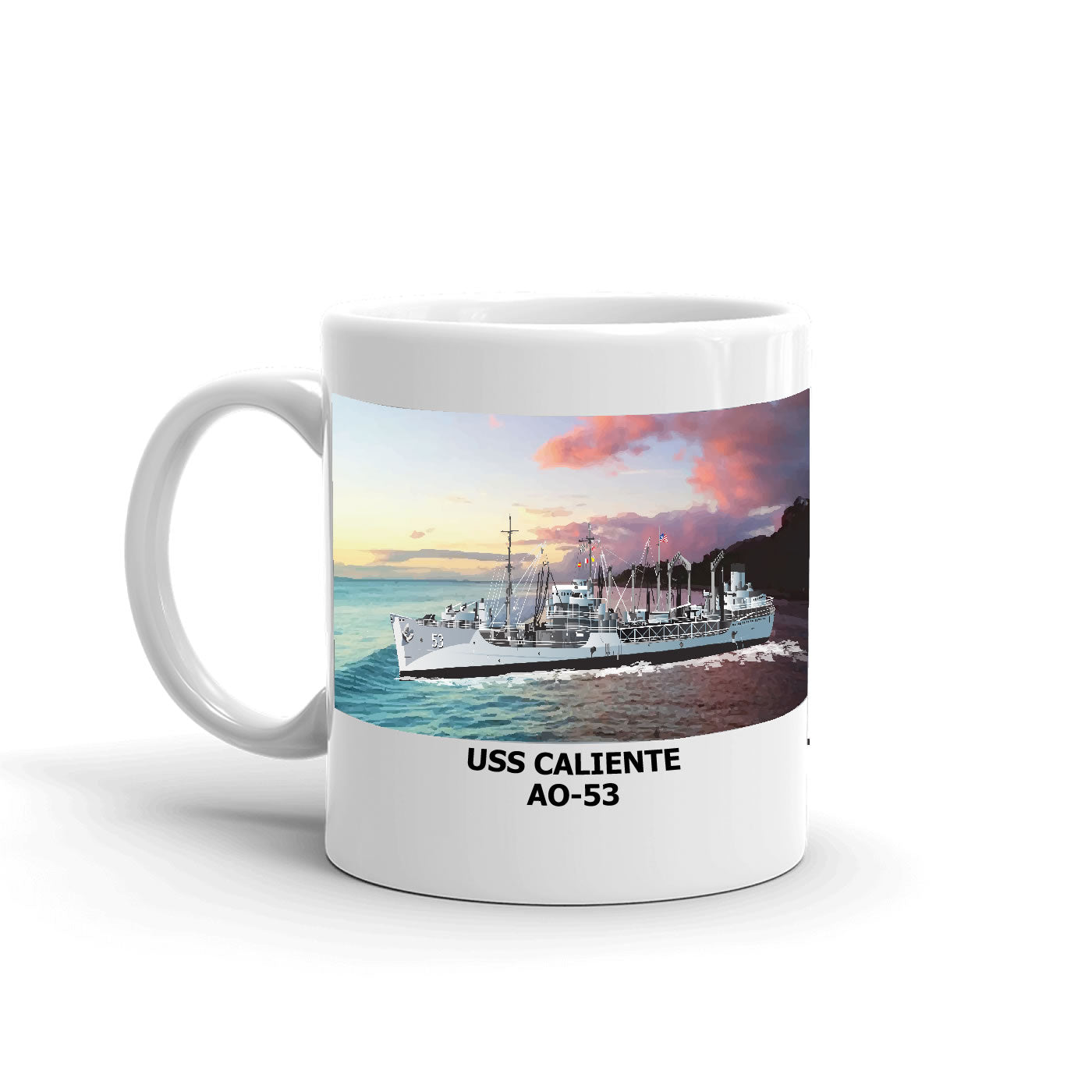The USS Caliente AO-53 is a bold symbol of America’s naval strength and bravery in the face of danger...from its vital support role during World War II and Korean War battleships refueling operations all the way through turbulent Vietnam War waters.
Experience Excellence: The Construction and Launch of USS Caliente AO-53
Constructed under a Maritime Commission contract, the mighty USS Caliente AO-53 came to life at the Bethlehem Steel Shipyard. This was no ordinary shipyard but one that had already marked its name in naval history with an impressive record of steel ship building.
This colossal structure took form as a Maritime Commission type (T3 S2-A3) hull. If you're curious about this classification, it simply refers to its design specifications for fleet operations support during World War II. As part of the American Naval Fighting Ships series, she was designed with efficiency and robustness in mind.
The site chosen for her birthplace? Sparrows Point., Maryland - A place known for creating vessels capable of enduring tough sea conditions while performing vital supply duties.
Breathing Life into Steel
Sparrows Point witnessed some historic moments on August 25, 1943, when USS Caliente first kissed water. The day was filled with anticipation and excitement; not just because another vessel was joining US Navy's ever-growing armada but because each launch represented hope during those war-torn times.
Laying down her keel required precision craftsmanship from experienced workers at Bethlehem Steel Corp. But what was the reason for this precise craftsmanship necessity? Well, every inch mattered. Precision engineering ensured smooth sailing through tumultuous waters while delivering critical supplies to our boys fighting across different theaters during World War II. You could almost feel their sense of accomplishment when looking upon what they'd built: A floating titan ready to serve the nation faithfully till final disposition.
Her First Voyage
The launch of USS Caliente was just the beginning. The next step? Commissioning. On October 12, 1943, she officially joined the ranks of active naval fighting ships under US Navy's command.
Before beginning the first voyage, extensive preparations must be made, similar to an athlete gearing up for a marathon. There are loads of preparations to be made before setting off on that first voyage.
Distinguishing Features and Purpose of USS Caliente AO-53
The USS Caliente AO-53, it's like the heavyweight champ of American naval design and has earned its stripes in the maritime history chronicles. The USS Caliente AO-53, a symbol of naval prowess, played an essential part in key wars that literally changed the face of our globe.
Bearing its name from Mount Caliente in Nevada, this ship's design was primarily centered around supply and refueling operations. Commissioned as part of the Naval Register for active service on October 12, 1943, it became an integral asset to western Pacific fleet operations throughout World War II.
When it comes to firepower and tech, the USS Caliente was decked out with some of the best in her league. Equipped with one single 5'/38 caliber gun mount; four twin 40mm AA gun mounts; four .50 cal machine guns; and two depth charge tracks, she packed quite a punch. Plus, with her roomy cargo tanks, she could carry tons of fuel - a real game-changer in long battles.
Fleet Oiler: The Lifeblood of Navy Operations
Serving as a vital artery within the US Navy’s lifeline system during times of war, USS Caliente provided essential services like resupplying ships with fuel at sea – making sure combat vessels could stay out longer without having to return to port for replenishment purposes alone.
This unique ability ensured efficient use of military resources while minimizing the risk of exposure to enemy attacks due to strategic positioning of logistics ships like herself deep inside friendly waters, away from the front lines of action when possible.
Armament And Weaponry for Self Defense and More
Apart from fulfilling logistic roles on the battlefield, every navy vessel needs to be capable of defending itself against potential threats both in the air and at sea. Hence, it was armed to the teeth.
One distinguishing feature of Caliente's weaponry is its 5'/38 caliber gun mount – an extremely versatile weapon used for anti-aircraft defense, shore bombardment, and surface engagements alike. But let's not forget about the firepower; it was nothing short of impressive.
The Legacy of USS Caliente AO-53 on US Navy
We simply can't talk about the game-changing influence of the USS Caliente AO-53 without acknowledging its priceless help to our fleet during key times like World War II, and in both Korea and Vietnam. This tough-as-nails vessel was nothing less than an indispensable component in the fierce machine that was America's naval forces.
Mission Capabilities
This hardy vessel wasn't just any steel shipyard product; it was an instrumental maritime force. The American Naval Fighting Ships bear testimony to how efficiently this battle-tested oiler fulfilled supply and refueling needs for many campaigns. Like a marathon runner passing batons in a relay race, it played a crucial role ensuring fuel availability for various aircraft carriers including USS Boston amongst others.
A key player within Western Pacific fleet raids and Northern Luzon campaigns during WWII alone, it also flexed its operational muscles far beyond those shores over time. With every mission undertaken by our naval forces from Sparrows Point right up till Long Beach operations, you'll find traces of the legacy left behind by USS Caliente AO-53.
Awards & Commendations
In recognition of her distinguished service record spanning multiple decades across different war zones around the globe, USS Caliente received numerous awards. These included Battle Stars as well as Campaign Stars - testaments not only to her reliability but more importantly her versatility under varying conditions.
The commendable performance won other prestigious honors such as Meritorious Unit Commendation which is equivalent to receiving National Defense Service Medal at unit level - quite an achievement indeed. Her dedication towards national defense has been rightly honored with Armed Forces Expeditionary Medal too signifying her active involvement in conflicts abroad.
During the turmoil of the Vietnam War, the Caliente stood strong and unwavering, an act that rightly earned her the highly sought-after Vietnam Service Medal. She stood tall and proud amongst other fleet units while serving under challenging circumstances. Not to forget, she also earned China Service Medal post WWII marking her participation in operations off China coast.
In short, it's clear that the impact of this vessel stretches far beyond its own physical presence.
Commissioning Details & Structural Specifications
A momentous day for the Naval Register as this marked another addition to the fleet ready to serve during World War II.
She served dutifully for over 30 years before being decommissioned in 1973. She served until December 15, 1973, when she was decommissioned and later struck from the Naval Register. Following that, she made her way into retirement within the National Defense Reserve Fleet.
A Closer Look at Her Structure
Structurally speaking, every detail about USS Caliente is a testament to naval engineering prowess. But what really stands out?
Built with robust materials capable of enduring harsh maritime conditions and battle zones alike. Each steel plate meticulously fitted together showcasing American naval craftsmanship.
The Anatomy of Strength
Every ship has its unique features - those aspects which make it stand apart from others in its class or era. The USS Caliente AO-53 is no exception.
Crafted with an exceptional attention-to-detail ethos in mind by engineers who were not just building a ship but crafting history piece by piece.
So, what's the big deal about these details anyway? Because these structural specifications give us insights into how such vessels are built to last – serving their purpose well beyond their initial commission date.
The Role of USS Caliente AO-53 in Major Conflicts
Over its three-decade run, the USS Caliente AO-53, a distinguished naval tanker, played a key role in trio of significant wars. The mighty USS Caliente AO-53 showed its mettle during three significant periods of strife: the tumultuous times of World War II, the icy conflicts of the Korean War, and the intense battles in Vietnam. This robust ship was the heart and soul of navy maneuvers in those chaotic periods.
Involvement in World War II
Barely out of her infancy when she was commissioned on October 12th, 1943 by the Maritime Commission under contract with Bethlehem Steel Corp at Sparrows Point, this 'steel giant' dove headfirst into the heart of battle. The ship's primary role involved refueling other vessels mid-ocean - a task it performed admirably throughout World War II.
Frequently stationed within range of enemy aircraft carriers and submarines, every mission held potential danger. Yet despite the perils faced daily from Axis forces or perilous sea conditions common to Western Pacific waters around Japan and Northern Luzon areas where many fleet raids were conducted, she never faltered but instead helped maintain operational efficiency for countless other fighting ships including American Naval Fighting Ships like USS Boston.
Participation in Korean & Vietnam Wars
Crossing over decades without missing a beat post-WWII era saw USS Caliente embarking upon fresh challenges as she partook extensively in both the Korean and Vietnam wars. She continued her resolute commitment towards supporting US Navy Fleet Operations across foreign seas that spanned thousands of miles away from home soil, even though risks grew more complex due to changes in warfare tactics utilized by adversaries, especially during the Tet/69 Counteroffensive phase which marked a turning point in the armed conflict region, particularly against the Communist China Spring Offensive.
During crucial events like the Communist China Spring Offensive, Korean Defense Summer-Fall 1952, and UN Summer-Fall Offensive, she was a game-changer for the US Navy in Korea. In the Advisory Campaign of Vietnam too, her role was crucial. For her outstanding work, she got a bunch of awards, including Battle Stars and the Navy Occupation Service Medal.
Crew Memories of the USS Caliente AO-53
The USS Caliente AO-53, a beacon of naval service and camaraderie, has left an indelible mark on the lives of its crew members, spanning from the fervor of World War II through the tumultuous times of the Vietnam War and the years in between. These memories, shared by the ship's crew, paint a vivid picture of life at sea, the bonds formed among sailors, and the pride taken in their service.
Sherwood Coltrain reminisces about his time in 1956 as a Boatswain's Mate Seaman (BMSN), highlighting the routine of running motor launches and the captain's gig, reflecting on the serene moments amidst the demanding naval life, likening it to being on vacation with time spent both at sea and in port.
Charles R. Rogers, who served as a Lieutenant Junior Grade (LTJG) in 1955, reaches out with a sense of nostalgia and pride, expressing a desire to reconnect with fellow crew members, especially officers and communications personnel, from the years 1955 to 1959. His words echo a sentiment of honor and fond remembrance for the great years spent aboard the Caliente.
The service of Frank L. Dominowski's father in 1944 as a Seaman First Class (S1C) during World War II is honored posthumously, with a mention of his honorable service and the personal loss felt by his family, underscoring the personal sacrifices made by those who served.
Paul Jacob, who boarded the ship in 1964 as a Storekeeper Third Class (SK3), reflects on his decision to join the Navy as one of the best in his life, cherishing the friendships and experiences that came with his service, encapsulating the spirit of naval camaraderie with a spirited "GO NAVY - BEAT ARMY."
James Rawlinson's efforts in 1970 as a Commissaryman Third Class (CS3) to organize a reunion in Boston underline the enduring bonds formed aboard the USS Caliente, inviting former shipmates to reconnect and share their stories once more.
Cosmas Raimondi, serving in 1965 as a Boatswain's Mate Third Class (BM3), recounts his three tours in the Vietnam theater and the significant promotions and friendships developed during his service, illustrating the challenging yet rewarding experiences of naval life during conflict.
Ernest Mathes, a Shipfitter Second Class (SF-2) in 1966, shares a memorable quote from the Executive Officer (XO) that encapsulates the sailor's ethos, with a personal testament to his continued love for the sea, exemplifying the deep-seated connection many sailors feel with the ocean.
The various roles and contributions of crew members, from radar operators like Norm Street in 1960 to electronic technicians like Bill Hightower, and others seeking connections, such as Tom Read, Dale Wales, Chuck Stowe, Lyle Richardson, Ronnie Jackson, Ro Bert Kimble, and Jerry Trillo, collectively weave a tapestry of dedication, adventure, and unity. Each memory, whether it's reaching out for old friends, recalling the best times of one's life even amid war, or simply sharing the pride of having served on the USS Caliente, contributes to the legacy of a ship that was much more than a mere vessel; it was a home, a training ground, and a place of lasting friendships.
The Final Disposition of USS Caliente AO-53
After a decorated career spanning multiple decades and wars, the fate of the USS Caliente AO-53 was ultimately sealed. On December 15, 1973, this distinguished ship was officially struck from the Naval Register.
This wasn't an abrupt goodbye though. It's as if our gallant veteran decided to take one last nap before its final journey. The USS Caliente AO-53 got transferred to none other than the Maritime Commission for a well-deserved lay up in National Defense Reserve Fleet.
You see, decommissioning doesn't necessarily mean 'end of life'. Just like old soldiers who retire but still have tales to tell and respect to command - these naval fighting ships too get their moments under the sun even after they're retired from active service. They become part of our heritage command – standing tall as reminders of naval history and national defense stories that deserve retelling over generations.
Laid Up but Not Forgotten
The tale didn’t end there with her laying low at some corner in Sparrows Point or Long Beach - far from it. For another few months, she rested amongst her fellow veterans - maybe sharing war tales or just silently observing fleet operations carried out by younger counterparts.
But then came April 5th, 1974; a date not celebrated but certainly remembered in American naval annals because on this day something inevitable happened: The maritime commission type hull called 'Caliente', which once used Bethlehem Steel Corp's expertise for construction at their steel shipyard, was sold off.
FAQs in Relation to Uss Caliente AO-53
What year was the USS Caliente AO-53 commissioned?
1943....October 12, 1943 to be exact!
How many crew members served on the USS Caliente AO-53?
The exact number varies over time, but a fleet oiler like the USS Caliente typically had around 300 officers and enlisted personnel onboard.
What type of missions did the USS Caliente AO-53 undertake during its service?
During the intense conflicts of World War II, along with the Korean and Vietnam Wars, this ship played a vital role - it was their source for fuel and supplies when they needed it most.
Where is the USS Caliente AO-53 located today?
Regrettably, the ship isn't in existence today. It got sold for scrapping after being decommissioned from service on December 15, 1974.
Are there any commemorative items available for purchase that honor those who served aboard the USS Caliente AO-53?
Certain online platforms might sell memorabilia related to this ship. Be sure to check out this website (NavyEmporium.com) for USS CALIENTE AO-53 items.
Final Farewell
We plunged into the rich saga of the USS Caliente AO-53, resurfacing with a chest full of maritime lore. The ship's construction by Bethlehem Steel set it sailing into history.
The USS Caliente supported military operations with fuel and cargo. So, what exactly was its job? Not just a pleasure cruise, the USS Caliente was critical in fueling operations during World War II, the Korean War and Vietnam conflict!
We reveled in USS Caliente's contributions to our nation’s defense - service that earned her multiple battle stars. Then came decommissioning; although she sailed no more after 1973, her legacy lives on.
Just like how we form vivid, detailed pictures in our minds while engrossed in a book or captivated by storytelling - full of characters, settings, and events - we often judge movie adaptations based on their ability to mirror these mental images. Keep in mind the USS Caliente, an enduring beacon of America's formidable dominance at sea! From inception to final disposition – each wave ridden adds a riveting chapter in US Naval History.
USS Caliente AO-53 Ship Specifications
| Specification | Details |
|---|---|
| Class | Cimarron Class Fleet Oiler |
| Commissioned | October 12, 1943 |
| Displacement | 25,425 tons |
| Length | 553 feet |
| Beam | 75 feet |
| Draft | 32.3 feet |
| Speed | 18.3 knots |
| Complement | 34 Officers 267 Enlisted |






